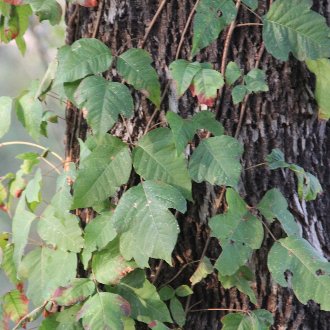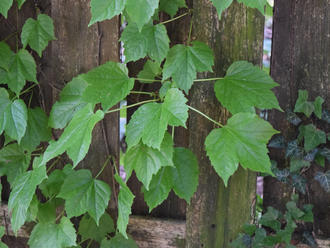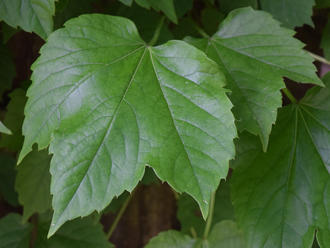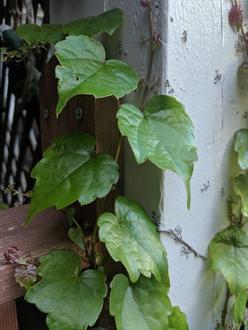Japanese Creeper (Parthenocissus tricuspidata (Siebold & Zucc.) Planch.)
Also known as Boston ivy.
↑Summary
A deciduous woody vine native to east Asia, introduced in North America. Established in numerous scattered locations, mostly around urban areas. It is a close relative of the native Virginia creeper. It is named for its cultivation in Boston, an area that was historically too cold to grow English Ivy. It is historically the ivy of the "Ivy League".
↑Range - Expand
| Legend | Color |
| Introduced | |
| Introduced or Not Present |
This tentative map is based on our own research. It may have limited data on Canada and/or Mexico, and there is some subjectivity in our assignment of plants as introduced vs. expanded. Read more in this blog post.
Although this plant occurs somewhere in each of these regions, it may only occur in a small part of some or all of them.
↑Description & Identification
A deciduous, woody vine with alternate leaves, climbing by tendrils with adhesive discs. Leaves variable: sometimes simple, three-lobed, sometimes compound, with three leaflets, occasionally two fused to produce an asymmetrical two-leaflet leaf. Leaf margins serrated, but serration on trifoliate leaves reduced between leaflets. Immature leaves on new growth often rounded, with lobes poorly-defined.
Foliage often shiny, fall color usually red, sometimes with some orange to dark purple. Although different leaves on a single vine typically change color at the same time, collections of multiple vines can display a wide range of colors. Growth to 50ft (15m.) in height.
Flowers 5-merous, greenish white, and relatively inconspicuous. Fruit a bluish-black berry, born in grape-like clusters, on stems that are reddish at the fruit's maturity.
Overall characteristics visibly similar to other Parthenocissus species.
↑Similar Plants
↑Habitat
In North America, mostly found around human areas where it has escaped cultivation, especially in urban areas. Found in gardens, around abandoned or poorly-maintained buildings, and along roadsides and railroads, especially near bridges, overpasses, and concrete barriers where it is able to root in fertile soil and climb sunny, exposed walls.
↑Life Cycle
Established seedlings sprawl across the ground and climb any suitable surface; able to effectively climb tree bark as well as wood, stone, brick, and concrete surfaces. Tolerant of light shade, but requires greater sunlight to flower and fruit. Usually takes a few years to reach maturity. Fruits are dispersed by birds.
↑Uses
Historically, widely cultivated as a landscaping plant, although there is little reason to plant this instead of the native Parthenocissus species. Nowadays, rarely planted.
↑Links & External Resources
• Parthenocissus tricuspidata (Boston Ivy) | Illinois Wildflowers (About This Site)
• Parthenocissus tricuspidata (Boston Ivy) | USDA PLANTS Database (About This Site)
• Parthenocissus tricuspidata | Go Botany (About This Site)
• Parthenocissus tricuspidata (Boston Ivy) | Missouri Botanical Garden Plant Finder (About This Site)
• Boston Ivy | Virginia Tech Dendrology Factsheets (About This Site)
• Parthenocissus tricuspidata | Biota of North America Project (BONAP) (About This Site)
• Parthenocissus tricuspidata | NatureServe Explorer (About This Site)
• Parthenocissus tricuspidata | Flora of North America (About This Site)
• Parthenocissus tricuspidata (Sieb. & Zucc.) Planch. (Boston-ivy) | Digital Atlas of the Virginia Flora (About This Site)









